
|

|
|
|

MINNEQUA Eleanor Parsons Keagle (1896-1971) Canton, PA - 1948 |
|
There have been many legends concerning Minnequa, some of them popularized in verse published by the author Peter MacKellar.
Of these, the two that have gained the most favor are the one of Minnequa, the chieftain’s beautiful daughter who was "sick unto death" but made a miraculous recovery when brought to drink the water of the magically healing spring, and the other of the "Giant of Minnequa."
This giant was supposed to have come marching over the hills centuries ago clad in satin with lace ruffles. He drank from the spring, drank again, and soon was making a continuous performance of imbibing the water, with his many servants carrying it to him. He grew prodigiously, split his fine clothes and eventually became a giant; all due to the magic water. At his death, he was so large that it was impossible to bury him so his followers laid him on the ground somewhat back from the spring and heaped dirt over him. It took so much dirt that eventually the hill upon which Rockgirt and other cottages stand was formed as the giant’s grave.
So much for the legends. For many years after Canton and Alba were settled the site of Minnequa was woods and a little partly cleared farmland. Not much was known about it until two brothers named Palmer, both lieutenants in the Civil War, returned home to Alba at the close of that conflict. In 1866 they built a log house a short distance north of the open spring and started to cut wood to fill a contract they had with the Northern Central Railroad requiring them to furnish fuel for the wood-burning engines then in use on that division. They and their families lived for a time in this log house.
At about this time James Reynolds established a carriage shop at Alba, which soon expanded into a big business employing many mechanics, and Alba became almost a "boom town." In this carriage shop the Herdic coach was built, which was first used in Washington, and later in other cities. It was horse-drawn, but in a way was a forerunner of the modern taxicab.
Evidently while Peter Herdic was in Alba in the interests of the Herdic coach, someone, presumably Luther Andress, introduced him to the Minnequa waters as a cure for rheumatism, from which he was suffering. The mineral and medicinal properties of the spring had just been established and, as the "cure" seemed to help Herdic, he immediately had visions of a great health resort hotel rivaling Saratoga Springs and other popular spas of the day.
With Peter Herdic, a vision seen was a plan to follow, so by 1869 he had acquired the spring together with many acres of adjoining land, had built a hotel and was ready for business. He had married Encie Maynard, daughter of Judge Maynard of Williamsport, for his second wife, and thus the judge acted as Peter’s legal and political adviser and added dignity and social poise to balance his son-in-law’s cash and flair for publicity. In 1870 Judge Maynard bought a 60-acre tract at Minnequa and erected a very fine cottage, which continued to be occupied by his descendants until sold to Dr. Smith of Pittsburgh a few years ago.
Though a man of little or no education, Herdic had great vision and imagination and was second only to the great Barnum in promotional ability. He had many friends in high places and, as the fame of his hotel grew, the circle from which the guests were drawn widened and by 1876 the hotel building had been enlarged to accommodate 600 guests comfortably together with the personal servants many brought with them. These guests came from Williamsport, Harrisburg, Philadelphia, New York, and Baltimore. Minnequa was a regular stop on the Northern Central Railroad and a station; telegraph office, post office and newsroom were part of the hotel.
One of the first and most important of Herdic's promotional work was to interest the famous actors E. L. Davenport, Frank Mayo, and the Rankins in the healing and youth-giving properties of the famous spring. They came in the early 70s and enjoyed their stay among the hills so much that they returned each year until 1874, when Mr. Davenport bought a home on upper Troy Street and named it "Lily Villa" in honor of his daughter. His son owned this property, known as the Davenport Villa, up to a few years ago. About the same time Mayo bought the adjoining property, and had the house which Francis Elliott was building finished according to his own ideas. A couple years later Miss Fannie Davenport bought Elliott’s third house known as "Hillside" and used it as a summer home until her death.
In case we here in Bradford County are inclined to feel smug and superior now, let me give you an extract from an interview Miss Davenport gave a Los Angeles reporter in October 1889, showing her opinion of the people of Canton of that time. "One finds such places as Canton only in the heart of an agricultural region. The people are quaint, crude, untraveled, but not uninteresting to a student of the species. They regard my home with unbounded wonder and spend hours looking at its gables, chimneys and towers, for it is a rambling old place with wide corridors, roomy recesses, stately chambers and an air of departed distinction about it." All this about a remodeled, overgrown farmhouse, built by a local contractor.
As early as 1872, Herdic conceived the idea of adding the western half of Bradford to the eastern, half of Tioga, forming a new county to be known as Minnequa County with Minnequa as the county seat. This was fought bitterly by Towanda and Troy, as well as by many Canton men who thought the taxation would be excessive. Peter’s influence in Harrisburg was great and he was so sure of winning that he built a second large building at Minnequa to be used as a courthouse and county office building. This building stood about 500 yards farther up the railroad and on the opposite side of the track. It was built of brick, five stories high next to the railroad and three on the side of the road. The building was not completed at the time the county was denied existence by a negative majority of only one vote in the Legislature but was completed later after the first hotel burned.
The hotel was managed by Will D. Tyler, who seemed very popular with the guests, and the whole establishment was at the height of its glory. A drill team and band, known as the "Herdic Grays," had been organized for some years; the members mostly being recruited from the employees of Reynolds Carriage Shop at Alba. They were splendidly equipped with gray uniforms and band instruments and played many concerts for the hotel visitors. Late in the fall of ’76 they must have been disbanded as their instruments were sold to a group at Leona.
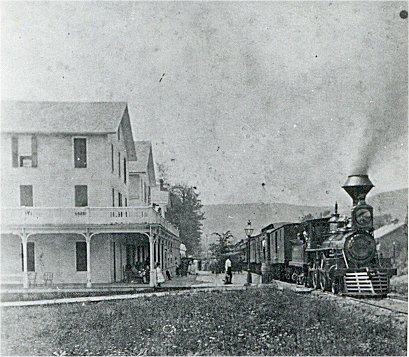 |
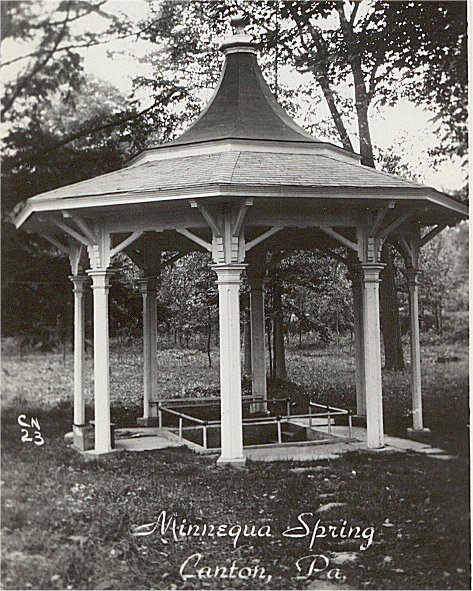 |
A few of the guests brought their own carriages and coachmen, but most of the others relied on the livery attached to the hotel and run by Jahiel and Hiram Lockwood or on the teams and surreys of the very popular Canton liveryman Levi Stull. There was such a demand for transportation to various points of interest that many farmers bought fine two and three-seated surreys and had a bust summer transporting Minnequa’s guests on their excursions.
To carry on the tradition that Minnequa Springs had been famous for it healing qualities among the Indians, Herdic imported three families of Penobscot Indians who lived on the "island" in shacks and wigwams, making baskets, bows and arrows, canes and other novelties to sell to the visitors. The same Indian families came for many years and were a great attraction to the hotel guests. The Canton Sentinel of July 27, 1876 has this to say: "The latest event at Minnequa was the baptism of a little Indian. An undoubted papoose was obtained, age 4 months, and named Agnes Minnequa. After the baptism the Pale Faces closed the day with a dance."
The baptism must have been effective, for there are records showing that one family of Indians, whose surname was Paul, spent the winter in Canton, and the children became members of the Baptist Sunday School. The island referred to was a short distance south of the spring. Here, according to legend, Minnequa, the chieftain’s daughter was buried, and there was a mound at the foot of a large hemlock supposed to be her grave.
In addition to the driving trips planned for Minnequa’s sojourners, there were many other social and intellectual entertainments. Mr. and Mrs. Davenport gave Shakespeare and other readings in the hotel parlors, and once they gave an open-air production of a Shakespearean play with a full cast of actors. The hotel had a first-class four-piece orchestra under the direction of R. Green and "Dress Hops" were a frequent diversion. The billiard rooms and bowling alleys also were much in use and frequent attractions were planned. One of these was on Aug. 15, 1876, when a balloon was sent up that landed in Williamsport at 8:37 p.m. making the distance in two hours and seven minutes.
On July 4, 1876, there was a grand celebration at Minnequa beginning with the arrival of the morning train from the south at 9:30 a.m. On the engine pilot a long plush covered seat had been built, and on this and in the engine cab were Gov. Hartranft; Thomas A. Scott, president of the Pennsylvania Railroad; A. K. McClure, editor of the Philadelphia Record; and other prominent men. This was a publicity stunt arranged by Herdic, the men probably only riding thus from Canton to Minnequa. Music was furnished by the Herdic Grays Military Band, with dancing and grand fireworks in the evening.
Lake Nepahwin was christened by Grace Greenwood, the famous author, the name being thought more euphonious than the old one of Gillett’s Pond. Notice of the new name appeared officially in the Canton Sentinel of May 25, 1876.
Each year Herdic tried to outdo his previous effort in a Fourth of July celebration and that of 1877 far outshone the one of 1876. This time he had the Hon. A. K. McClure, Gen. McCandless, Gen. Gollis, Col. McMichael, the Hon. Stanley Woodward and others as speakers, and the famous Repaz Band of Williamsport furnished the music. Dinner was served from 1 to 5 p.m. to more that 1,000 diners, and there was considerable criticism of the balance of the 6,000 persons present for not patronizing the hotel dining room instead of bringing basket lunches.
The height of the season at Minnequa was from Aug. 1 to Sept. 15, but there were always a goodly number of guests from July on. In 1877, Herdic had 8-inch water mains laid from Canton to Minnequa, and in this year many of Canton’s homes enjoyed their first taste of city water.
Early in 1878, Herdic went bankrupt for the huge sum of $2 million, with almost no visible assets. The Minnequa House was taken over by the Minnequa Improvement Co., and that summer a new building of some sort was erected by imported colored labor. The season was not quite as successful as formerly, and the knell of the golden age was sounded by the fire bell, which announced the burning of the hotel on Nov. 12, 1878. The origin of the fire has always remained a mystery. The loss was $75,000 with $50,000 insurance.
Even the famous health-giving properties of the spring could not outweigh the double disaster of Herdic’s colossal failure and the fire, so there was very little activity until 1884, at which time the Maynard Estate remodeled the brick building, which had been started as a courthouse, and added porches on all floors entirely around the building. These porches were advertised to contain 10,000 square feet of floor space. The hotel had electric bells in every room; steam heat; gaslights; and an elevator, which though slow, was quite efficient, being operated by waterpower. There were semi-weekly "hops" with music by Stopper and Fisk’s famous orchestra from Williamsport, and guests were guaranteed plenty of dancing partners, many of whom were the boys from Canton and Troy.
Between 1885 and 1891, the Rev. Arthur Brooks, Mrs. C. Maynard Parker, Mrs. Thomas J. Owen, Miss F. A. Smith and Henry A. Oakley of New York City built beautiful cottages on Maynard Hill, and the Rev. Stephen W. Dana of Philadelphia had built on the hill’s southern slope, and Minnequa was on the way to a new life.
The main part of the hotel was 75 by 100 feet, with an addition 100 feet long containing, among other things, a ballroom with a solid walnut floor. There was an outdoor dancing pavilion where square dancing was enjoyed. The hotel had accommodations for 125 guests and for its time was very modern. It never enjoyed the success of its predecessor, however, probably due in part to the lack of Herdic’s indefatigable ballyhoo and partly because other resorts had become attractive to Minnequa’s former patrons. At the time of the second fire, which occurred May 13, 1903, the hotel had been closed for two seasons, and was then under option to a group of New York and Philadelphia doctors, who had planned to use it as a sanitarium.
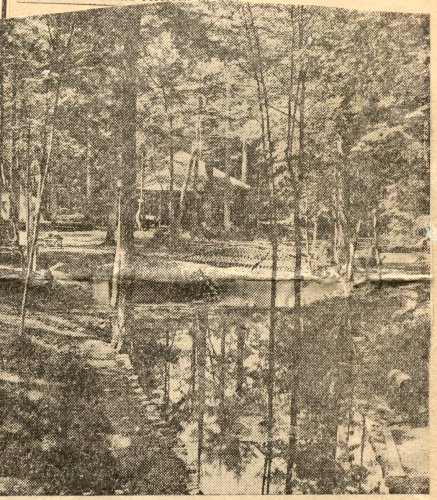 |
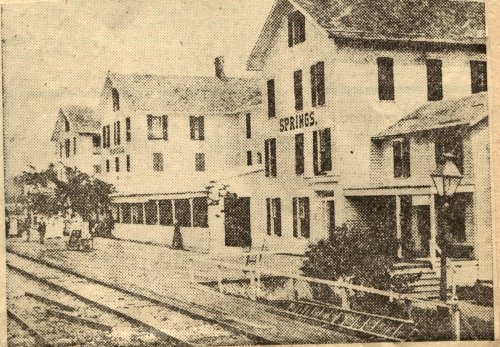 |
| More than a mile of boardwalks like the one above stretched through the woodlands. The creek was always kept clean and some of the banks were walled. All underbrush was cleared out of the woods each year. | Close-up of the Minnequa Hotel showing railroad platform and baggage
trucks. The Minnequa station was in part of the hotel. |
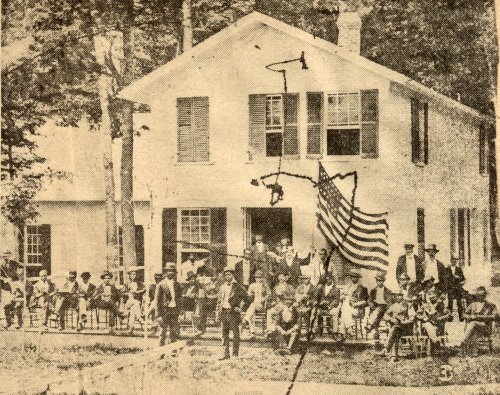 |
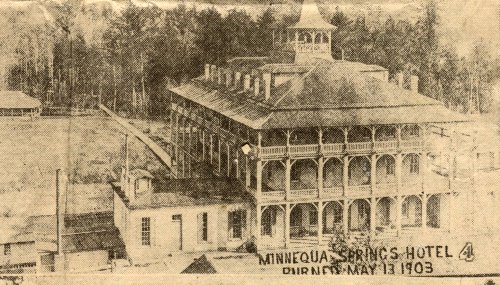 |
| Negro waiters at the old Minnequa House. Some of them composed a baseball club called the Mohawks. This building was the telegraph office to the left of the hotel and about 50 yards from it. | The second Minnequa Springs Hotel as it appeared from the highway. The long board walk at rear led to the spring and to more than a mile and half of walks through the woods. Note buildings on hillside at rear. |
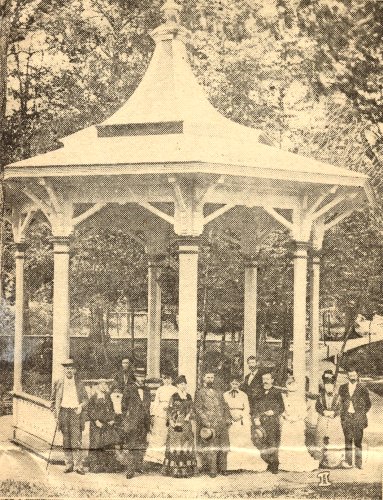 |
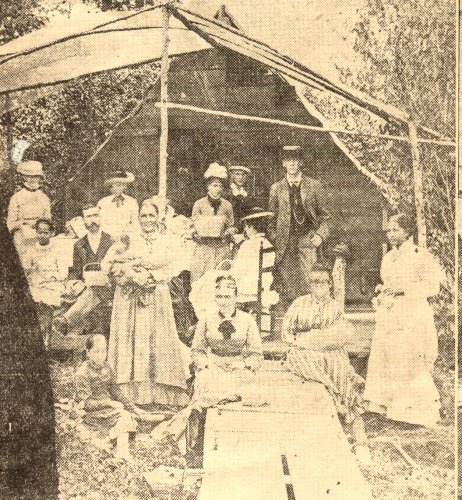 |
| A group of Minnequa Springs guests at the once famed spring. This is the only building now remaining. first man at the left is Luther Andress; man in center wearing beard is Jim Canfield. | group of Indians brought to the spa for "atmosphere." They are shown here with some of the baskets they wove. The baby in the picture is "Agnes Minnequa." Some of the women are "paleface" callers. |
|
|||
|